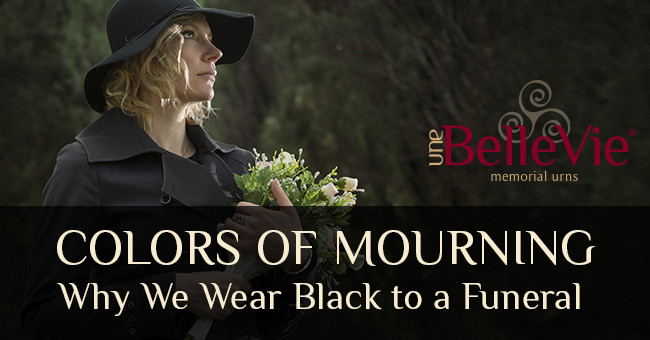At a Funeral, Is It Proper for Non-family Members to Wear Black?
The wearing of blackness clothing has been a long-accustomed funeral tradition intended to show respect for the deceased. Wearing other colors is in fact seen as a major socialfaux pas, or an out and out slap in the face to mourning family members, regardless of how subdued or otherwise formal the offending clothing is.
By the late 19th century, black habiliment had get and so associated with the human activity or process of mourning that any woman who dared habiliment black when not in mourning was looked down upon and seen equally "dangerously eccentric."
And so where did this association come from? What was its original purpose? Why has it been so persistent? Do other cultures permit mourners or funeral-goers more than leeway when information technology comes to the color of mourning wearing apparel?

Colors of Mourning in the W
The easy answer to the first of these questions is to say that we wear black because that's just the way information technology's ever been – and for all intents and purposes, for nearly of us that's true. The tradition of blackness mourning clothing in the West dates back to the Roman Empire, when the family of the deceased would wear a dark-colored toga, chosen atoga pulla. This tradition persisted in England throughout medieval times, when women were expected to wear black caps and veils when their husbands passed away.
In much of continental Europe however, widows in the deepest mourning period wore white, a tradition that held on in Kingdom of spain through most of the 1500s. French queens prior to the Revolution also wore white while in mourning.
Royal and Grayness – Colors of "One-half Mourning"
Flash frontwards to England during the Victorian era, where women were expected to dress in mourning for up to 4 years. Even so, once she entered what was known as "half-mourning" – a twelvemonth after being widowed – the bereaved could incorporate purple or grayness into her wardrobe.
Prior to this era, formal mourning was largely reserved for the upper classes. But with the birth of the heart grade during the industrial revolution, the exercise grew and spread throughout guild.
Because funeral customs in the US tend to closely mimic those of the UK, the tradition of black mourning attire crossed the Atlantic, and by the late 1800s had become and then firmly entrenched in our ain culture that department stores like Lord & Taylor had unabridged mourning departments to meet this demand.
Today, while these traditions have persisted in the US and Western Europe, other cultures and non-western religions naturally maintain their own rich traditions, many of which incorporate a wide variety of other mourning colors.
Mourning Colors Effectually the Earth
We can acquire much from looking at the funeral clothing and mourning traditions of other cultures. We could potentially fifty-fifty comprise some of these beautiful customs into our own funeral celebrations. This would be especially appropriate to celebrate the beautiful life of a loved one who enjoyed traveling, or reading and learning near other cultures.
White as a Color of Mourning
White has long played a role in the history of mourning. White has been representative of purity through many centuries and in many parts of the world. The presence of youth at a funeral, whether every bit the deceased, a mourner, or in a participatory capacity, is often distinguished by white every bit a symbol of innocence and purity. The attire of women too, while commonly dominated by black in mourning, often has been accompanied by white accouterments such equally hats, accessories, or the trim of a mourning dress.
- The funeral for King Leo V of Armenia featured a procession clad entirely in white. The funeral was held in 1393 in Paris, French republic, where King Leo V died in exile.
- In 1962, Wilhelmina, who had abdicated the throne of kingdom of the netherlands in 1948, was given a white funeral in respect for her spiritual belief that earthly death was the showtime of eternal life. This has become a tradition with the Dutch purple family, exemplified in 2004 when Queen Juliana'south daughters all wore white to her funeral.
- Queen Fabiola wore white in 1993 at the funeral of her husband, King Baudouin I of Belgium.
- White is the colour of mourning in Hindu culture every bit a representation of purity.
Other Colors of Mourning:
In our search for the use and symbolism of colors of mourning, black and white constitute common threads beyond cultures. Additionally, yellowish has long been a color of mourning in Arab republic of egypt every bit information technology is associated with both the sun and the gilded used with so many mummies and sarcophagi. Ruby-red is a common funeral color in Ghana amid native cultures. The Catholic Church has introduced the utilize of purple in mourning in many countries influenced past the religion.
Do you accept farther questions nearly funeral planning or mourning etiquette? View our funeral and estate planning section of our blog.
Source: https://decorative-urns.com/cremation-blog/managing-grief/why-we-wear-black-to-a-funeral/
0 Response to "At a Funeral, Is It Proper for Non-family Members to Wear Black?"
Post a Comment